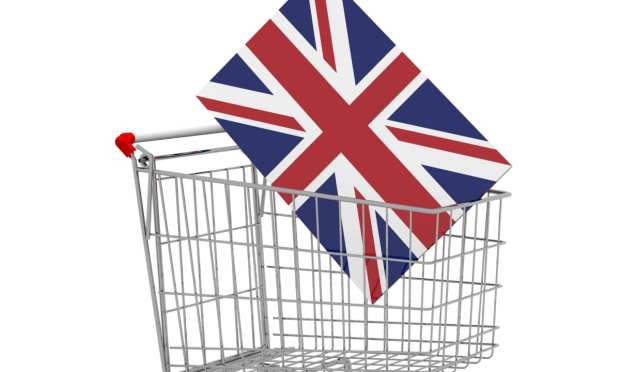UK Merchants Reckon With Post-Pandemic Contactless Retail Reality

Consumers in the U.K., much like consumers most everywhere, have gone decidedly digital in the last 12 months, a fact demonstrated by the numbers in the recently released PYMNTS/Cybersource Global Digital Shopping Index U.K. Edition. Close to half of all U.K. consumers — 46 percent — now prefer to start their shopping trips digitally, while 63 percent of those within this group want their purchases delivered to their homes. The share of brick-and-mortar shoppers has declined by 11 percent, to the point where in-store shopping is preferred by just 54 percent of U.K. consumers, while the share of online cross-channel shoppers has grown by 14 percent since the pandemic began.
What consumers have learned to love and appreciate, Cybersource Director of Unified Commerce Solutions Lee Tango and Karen Webster agreed in a recent conversation, is that the digital experience offers more appealing features to them than the physical store. It’s not simply an anti-COVID defense.
Merchants hoping to bring consumers back to the store should be mindful of that reality, he said. For some consumers, though certainly not all, may not plan to return at all. The question for retailers to wrestle with is how to build an experience that speaks to everyone, regardless of whether it’s online or in person.
“It’s really important that retailers recognize that we’ve accelerated across the board — as consumers, as retailers — three to five years, if not more,” Tango said. “There are people who converted previously, as well as digital resistors who will now convert and forevermore be digital-first. And there will be people who’ve done the whole digital thing because it’s a necessity and will be raring to get back into stores for a face-to-face experience. And that’s why I think the next 12 to 18 months will be tricky, because how do you balance those priorities?”
The challenge retailers face going forward, as the recovery period gets underway, will be finding the paths and striking the partnerships that provide a seamless retail experience regardless of the channel, allowing customers to capture their goods or services “either as quickly or as conveniently for their needs” as possible. “That way it doesn’t matter what happens with the evolution of mobile, because you’ve positioned yourself in the space that your consumers want you to be in,” Tango said.
Creating A New Experience Around Contactless
The emerging preference for contactless payments evidenced in the report, Tango said, presents an excellent example of the “bigger-picture thinking” that the next era of digital commerce will require from merchants.
Contactless is big in the U.K., the report found, as 55 percent of consumers reported using this digital feature. And while that figure is split between mobile wallet-based contactless payments like NFC and QR codes and contactless cards, looking ahead, Tango said, it’s mobile payments that present a really exciting opportunity.
“Contactless cards have an important role to play, especially in the U.K.,” he said. “The benefit of the mobile phone is that it brings the ability to drive those richer interactions. With the card, the payment experience starts and ends with a payment. With the smartphone, you have the ability to build ecosystems in and around the payment experience that allow you to understand and know your customer, and reward loyalty.”
This deeper knowledge opens up the option to bring an almost “white-glove” element to the in-store transaction experience, where customers can build a trusted relationship that allows them to complete a payment without even having to take out their phone. Instead, merchants can pull up their information and see the card on file as well as home delivery credentials in place.
“It creates an opportunity to use payments to bring what consumers love about the digital journey into that in-store environment,” Tango said. “I think in-store environments still have a huge role to play moving forward, but we need to collectively get better at bringing things like immediacy of information, immediacy of availability and seamlessness into that experience.”
Building Retail’s Next Phase
Tango noted that retailers deserve credit for the digital shift they managed to pull off at the drop of a hat over the last year, as pushing several years’ worth of progress forward in the span of a single year is no small accomplishment. And yet, in many ways, the work has just begun when it comes to delivering on the digital promises the future holds.
“I think over the coming years, we’ll see a separation of ‘haves and have nots’ in regard to the technical debt they’ve incurred on their back end, especially in the short-term period, where they’ve had to be very agile and adapt their business processes,” he said. “Because everybody in this industry knows the longer you build on a fragile back end, the more restrictive it will become to your front-end experience in the long term.”
It’s not the most glamorous investment, noted Tango — but the firms that have accelerated most quickly are the ones that started on a solid technical foundation, and there is no hope of living up to consumers’ advancing expectations without one.
The good news, he said, is that firms don’t have to build this on their own — and, in fact, most realistically cannot. The key is to figure out the right priority set to pursue and to work with the right partners that can help deliver on the retailer’s vision for the consumer’s shopping journey. Because as the data undeniably shows, that journey has been forever altered.
“My advice to retailers is: Don’t fear it — embrace it and respect it,” Tango said. “The future will be about changing the way you interact with these customers and using the power of your digital platform to do it.”
